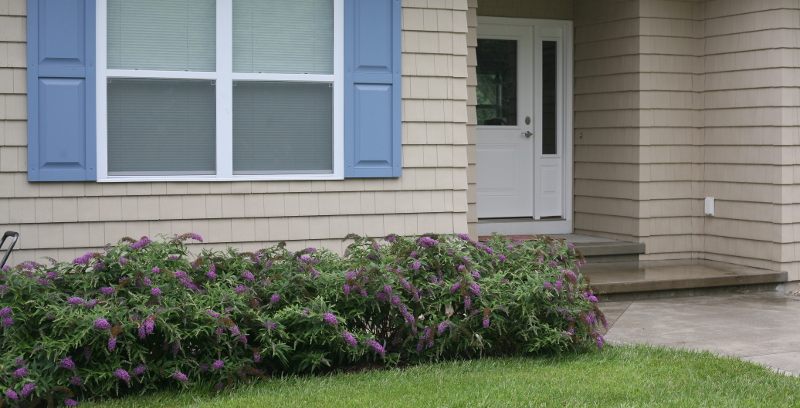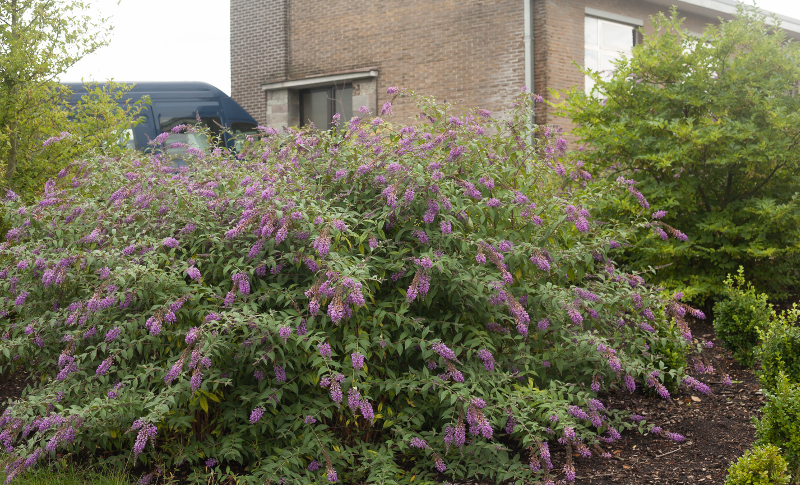Since butterfly bushes grow on new wood each spring, pruning keeps them shaped nicely and from becoming overgrown. This is especially helpful if you are growing a hedge or garden border. Here are tips for timing pruning of butterfly bushes.

When to Prune Butterfly Bush
The best time to prune butterfly bushes (Buddleja) is spring in most growing regions. With these rapid growers, you can be slightly off on pruning, but they tend to grow to a good size anyway. Still, they can get damaged by frost or set back by pruning too soon or too late.
Butterfly bush growth appears on new wood, so pruning can wait until the new wood is ready to grow in spring. Since most butterfly bush varieties can handle cold down to zone 5, they grow in plenty of climates with fall, winter, or spring freezes. Wait to prune your butterfly bush until late winter or early spring. Cutting the stems back in fall can make the shrub more vulnerable to freeze damage.
The shrub will tell you when to prune by showing new, healthy looking leaves forming low, near the plant's base. Be patient, since it might not leaf out until after other perennials.

If you live in a mild climate, fall can be a good time to prune a large butterfly bush, but you also can wait until early spring.
Avoid pruning after the shrub starts forming flower buds; you could remove future flowers. Deadheading spent flowers is a better approach, but not necessary in most cases.
How to Prune Butterfly Bushes
Step 1 – Look for new growth.
In late winter or early spring, butterfly bush leaves begin appearing low on the plant. Wait until you see several signs of healthy leaves.
Step 2 – Cut just above new leaves.
Make a clean, angled cut just above where those healthy leaves appear.
Step 3 – Check your variety.
Most standard butterfly bushes (B. davidii) look best if pruned close to the ground in late winter; other types, such as small or dwarf varieties like Lo and Behold, require lighter pruning.
Step 4 – Prune out dead stems.
Look for older, dead stems and cut them close to the ground.
Step 5 – Walk around the plant.
Be sure to look at the plant from all angles and make lighter pruning cuts to shape it as desired.
Use the same technique—based on variety—for fall pruning of butterfly bushes.
Butterfly bushes grown in pots might need heavier pruning than other dwarf varieties.
Why Prune Butterfly Bushes
Pruning larger butterfly bushes to nearly ground level gives the shrub a nice, new start to its shape each year. Cutting back dwarf varieties helps remove any dead stems and shapes the shrub for the location and personal preference for shape.

Failing to prune, especially for large butterfly bushes, can lead to plants that are too tall and have leggy growth and fewer flowers, since the plant needs energy just to feed the leaves on long stems.
Don't worry about pruning heavily every few years to rejuvenate and reshape an overgrown butterfly bush. You can do so without killing it, unless you prune when the weather is too cold.
Deadheading is not necessary on most butterfly bushes, but it can help stimulate further blooming later in the season. If you have a nonsterile variety, deadheading spent blooms keeps the buddleja from reseeding and becoming invasive. Most varieties are nonsterile, however.
Butterfly Bush Pruning Tips
- If possible, have a pair of anvil loppers and a pair of bypass loppers ready for large butterfly bushes.
- Use bypass loppers on large, green stems, and the anvil loppers work best on dead wood.
- Also have a pair of bypass pruners ready for small stems and shaping cuts.
- The warmer your climate, the more you should prune large butterfly bushes each spring.
- Some small or dwarf varieties of butterfly bush need no pruning.
 |
Author Teresa Odle - Published 7-06-2020 |
